John Henry Foley RA RHA (1818-1874)
Signature: signed and dated lower left
Medium: bronze
Size: 3.40 x 20 x 9½in. (8.64 x 50.80 x 24.13cm) In 1834 the sixteen-year old John Henry Foley left his native Dublin for London, following in the footsteps of his elder brother Edward, already established at the sculpture workshop of the celebrated Mr Behnes. He enrolled in the school of the Royal...Read more In 1834 the sixteen-year old John Henry Foley left his native Dublin for London, following in the footsteps of his elder brother Edward, already established at the sculpture workshop of the celebrated Mr Behnes. He enrolled in the school of the Royal Academy and quickly won a studentship for ten years with The Death of Abel. This piece and Innocence, perhaps inspired by his sister Martha, were exhibited at the Royal Academy in 1839 to great acclaim. Foley's talent was recognised by the influential Art Journal. The following year Ino and Bacchus was exhibited, to even greater acclaim.In both subject matter and style it is a neo-classical piece. That is to say it imitates the art of ancient Greece and Rome.The infant Bacchus lies on his back, smiling, reaching for the bunch of grapes dangled above him by the bare- breasted Ino who lies, smiling, at his side and leans over him. The naturalness, charm and wit of the piece affected all who saw it. Prince Albert, the Queen's consort, was enthusiastic.Francis Egerton, Earl of Ellesmere, commissioned a marble copy for his gallery at Bridgewater House. This poet-politician had inherited property worth £90,000 a year and a fabulous collection of paintings. He was sworn to the privy councils of both Britain and Ireland. He translated French and German literature - he was London's equivalent of Macaenas, Rome's great patron of the Arts.Ino and Bacchus marked a turning point in the career of the twenty-two year old from Montgomery Street, Dublin, (Now Foley Street, just north of Talbot Street.) Son of Jesse Foley, glass-blower turned grocer, and Eliza Byrne, from Wicklow. It launched him upon a career-path that led to the heart of Victorian society and major commissions for projects across the imperial globe from Galway to Calcutta.At first sight, Ino and Bacchus offers a domestic scene that might be set anywhere from Moycullen to Mayfair. Foley and Egerton knew there was more to it. Around the couch upon which the figures lie is a kind of frieze displaying leaves, fruit and faces from the pantheon of classical gods. This reminds us that the woman and child in whose play we delight are not figures from a back garden in Kensington but from the harsh, complicated milieu of Greek mythology, which has little to offer in the way of innocence. Ino was one of four daughters of Cadmus, founder of Thebes. She married Athamas, king of Boeotia, when his first spouse Neplele, the cloud goddess, having given birth to Phrixus and Helle, returned to the sky. Ino bore Athamas two sons, Learchus and Melicertes but she was jealous of her stepchildren and plotted their death...Bacchus (Dionysus in his Greek expression) was the son of Ino's sister Semele by Zeus (God-the-father in the Greek pantheon). Ino's nursing Bacchus angered Hera, wife and sister of Zeus. She persuaded Tisiphone, a fury from Hell, to attack Athamas and Ino and drive them mad. Athamas, convinced that Ino and her babies were a lioness and two cubs, tore Learchus from Ino's arms and flung him against a wall. Ino, still holding Melicertes, climbed a cliff near the water and leapt into the sea. But, Aphrodite, Goddess of Love, called on Poseidon, God of the Sea, to change mother and son into sea-creatures...Bacchus, God of Wine (trademark the grape), gives his name in this, its Latinate, form to the Dionysiac orgies - bacchanalia - that accompanied his worship. The ceremonies of Bacchus were marked by ecstatic abandon and included drunkenness, wild dancing and the dismemberment of wild animals. Maenads (female followers of Bacchus) became possessed by the wanton spirit of the God. With satyrs (preternatural male followers of the same)
John Henry Foley RA RHA (1818-1874)
Signature: signed and dated lower left
Medium: bronze
Size: 3.40 x 20 x 9½in. (8.64 x 50.80 x 24.13cm) In 1834 the sixteen-year old John Henry Foley left his native Dublin for London, following in the footsteps of his elder brother Edward, already established at the sculpture workshop of the celebrated Mr Behnes. He enrolled in the school of the Royal...Read more In 1834 the sixteen-year old John Henry Foley left his native Dublin for London, following in the footsteps of his elder brother Edward, already established at the sculpture workshop of the celebrated Mr Behnes. He enrolled in the school of the Royal Academy and quickly won a studentship for ten years with The Death of Abel. This piece and Innocence, perhaps inspired by his sister Martha, were exhibited at the Royal Academy in 1839 to great acclaim. Foley's talent was recognised by the influential Art Journal. The following year Ino and Bacchus was exhibited, to even greater acclaim.In both subject matter and style it is a neo-classical piece. That is to say it imitates the art of ancient Greece and Rome.The infant Bacchus lies on his back, smiling, reaching for the bunch of grapes dangled above him by the bare- breasted Ino who lies, smiling, at his side and leans over him. The naturalness, charm and wit of the piece affected all who saw it. Prince Albert, the Queen's consort, was enthusiastic.Francis Egerton, Earl of Ellesmere, commissioned a marble copy for his gallery at Bridgewater House. This poet-politician had inherited property worth £90,000 a year and a fabulous collection of paintings. He was sworn to the privy councils of both Britain and Ireland. He translated French and German literature - he was London's equivalent of Macaenas, Rome's great patron of the Arts.Ino and Bacchus marked a turning point in the career of the twenty-two year old from Montgomery Street, Dublin, (Now Foley Street, just north of Talbot Street.) Son of Jesse Foley, glass-blower turned grocer, and Eliza Byrne, from Wicklow. It launched him upon a career-path that led to the heart of Victorian society and major commissions for projects across the imperial globe from Galway to Calcutta.At first sight, Ino and Bacchus offers a domestic scene that might be set anywhere from Moycullen to Mayfair. Foley and Egerton knew there was more to it. Around the couch upon which the figures lie is a kind of frieze displaying leaves, fruit and faces from the pantheon of classical gods. This reminds us that the woman and child in whose play we delight are not figures from a back garden in Kensington but from the harsh, complicated milieu of Greek mythology, which has little to offer in the way of innocence. Ino was one of four daughters of Cadmus, founder of Thebes. She married Athamas, king of Boeotia, when his first spouse Neplele, the cloud goddess, having given birth to Phrixus and Helle, returned to the sky. Ino bore Athamas two sons, Learchus and Melicertes but she was jealous of her stepchildren and plotted their death...Bacchus (Dionysus in his Greek expression) was the son of Ino's sister Semele by Zeus (God-the-father in the Greek pantheon). Ino's nursing Bacchus angered Hera, wife and sister of Zeus. She persuaded Tisiphone, a fury from Hell, to attack Athamas and Ino and drive them mad. Athamas, convinced that Ino and her babies were a lioness and two cubs, tore Learchus from Ino's arms and flung him against a wall. Ino, still holding Melicertes, climbed a cliff near the water and leapt into the sea. But, Aphrodite, Goddess of Love, called on Poseidon, God of the Sea, to change mother and son into sea-creatures...Bacchus, God of Wine (trademark the grape), gives his name in this, its Latinate, form to the Dionysiac orgies - bacchanalia - that accompanied his worship. The ceremonies of Bacchus were marked by ecstatic abandon and included drunkenness, wild dancing and the dismemberment of wild animals. Maenads (female followers of Bacchus) became possessed by the wanton spirit of the God. With satyrs (preternatural male followers of the same)

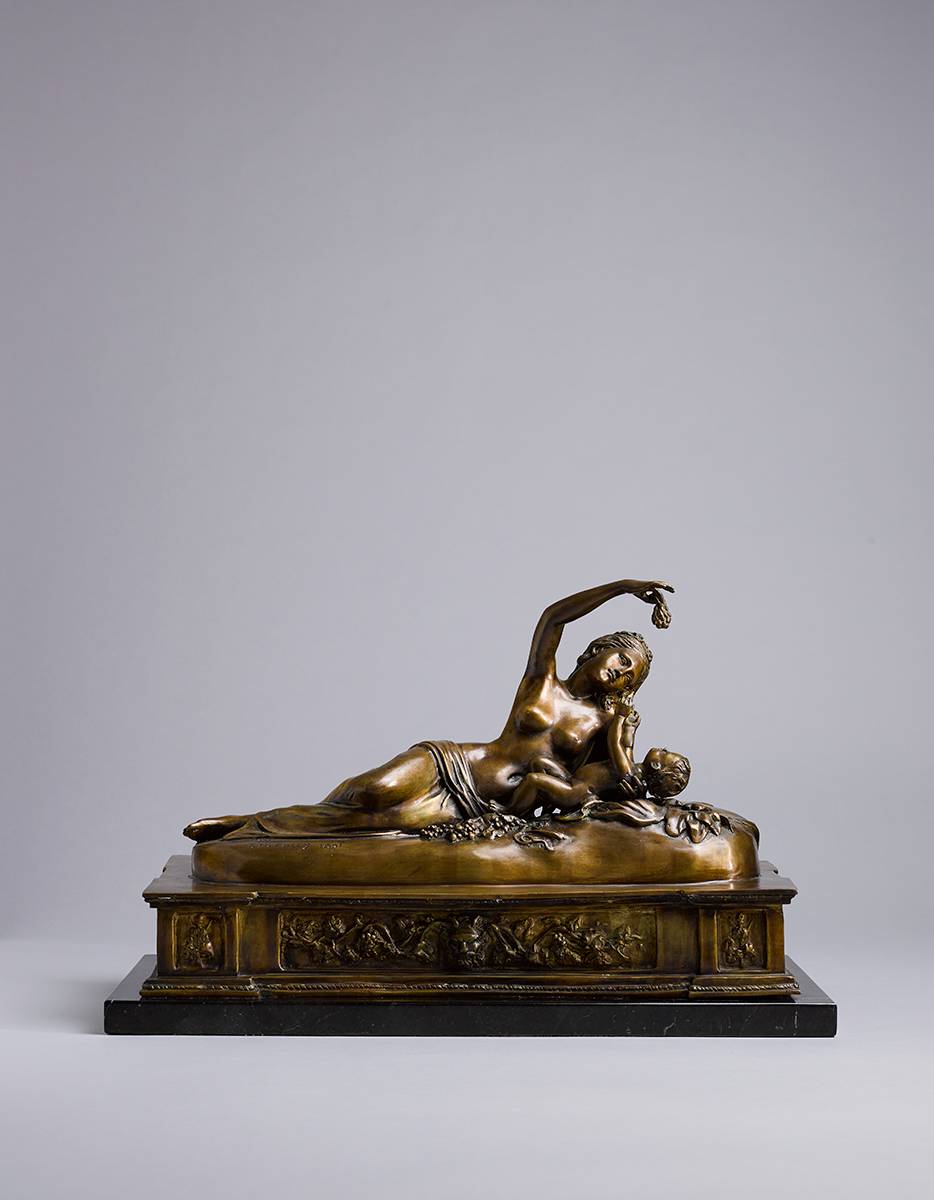
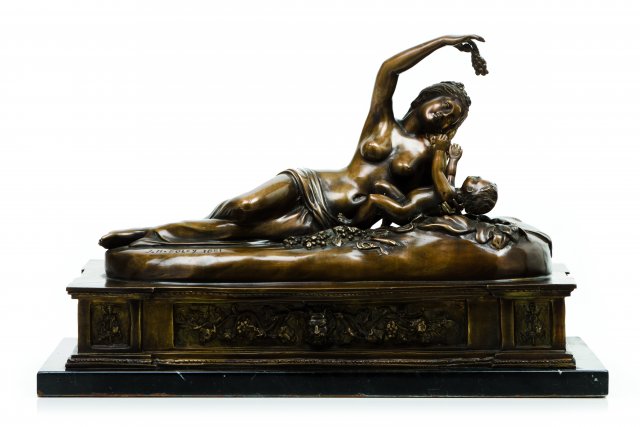
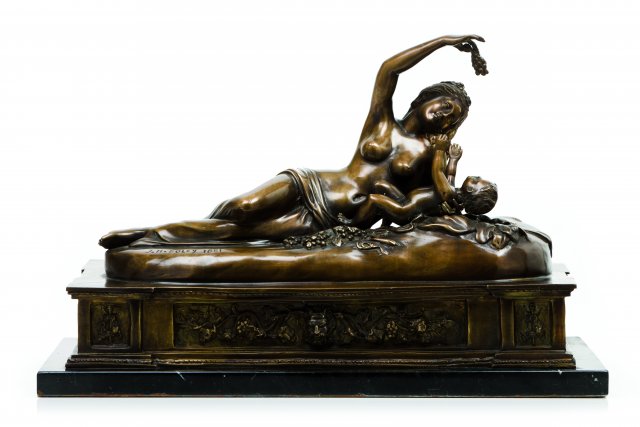
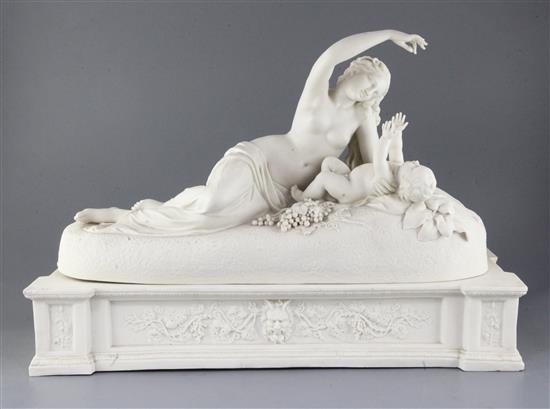



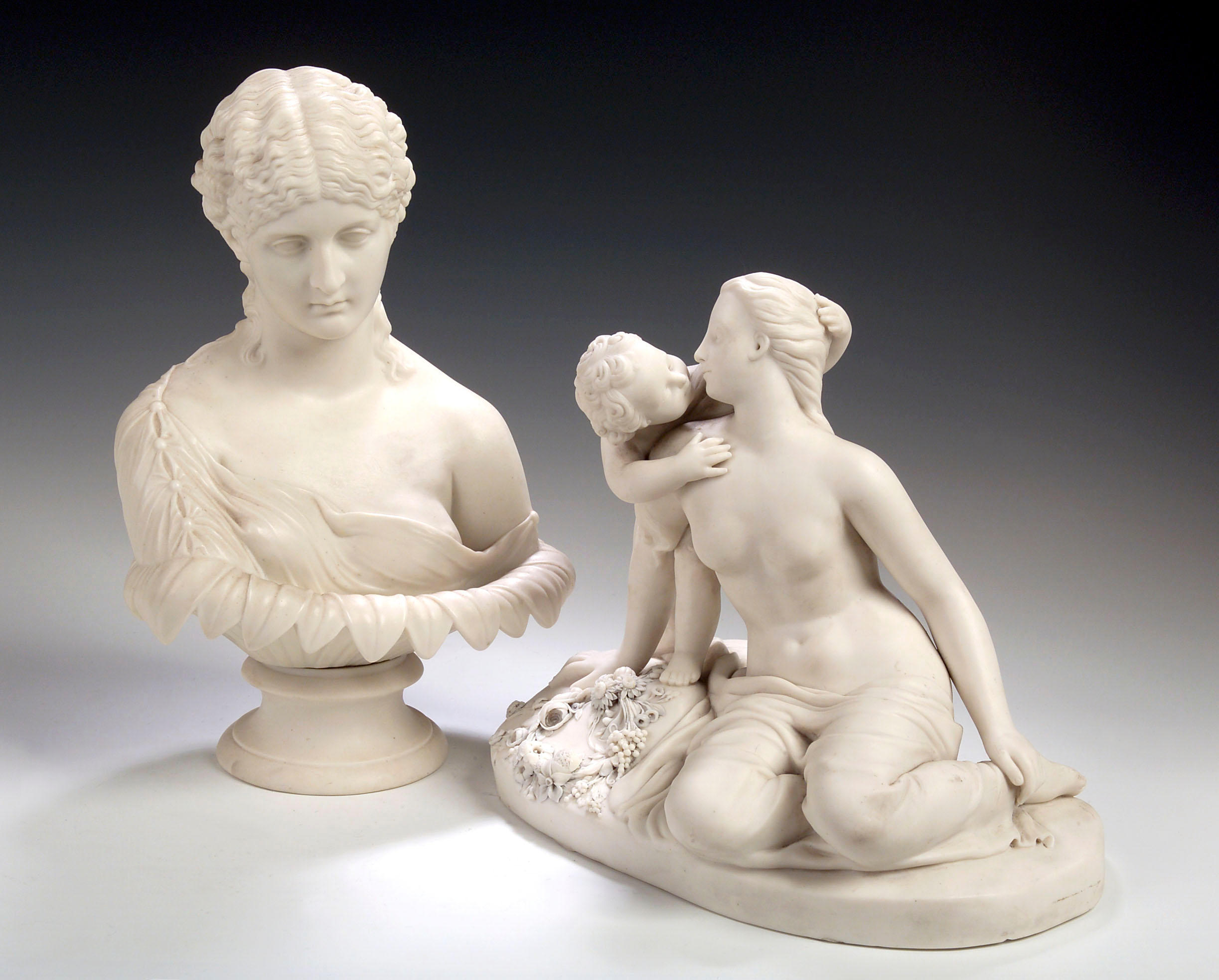
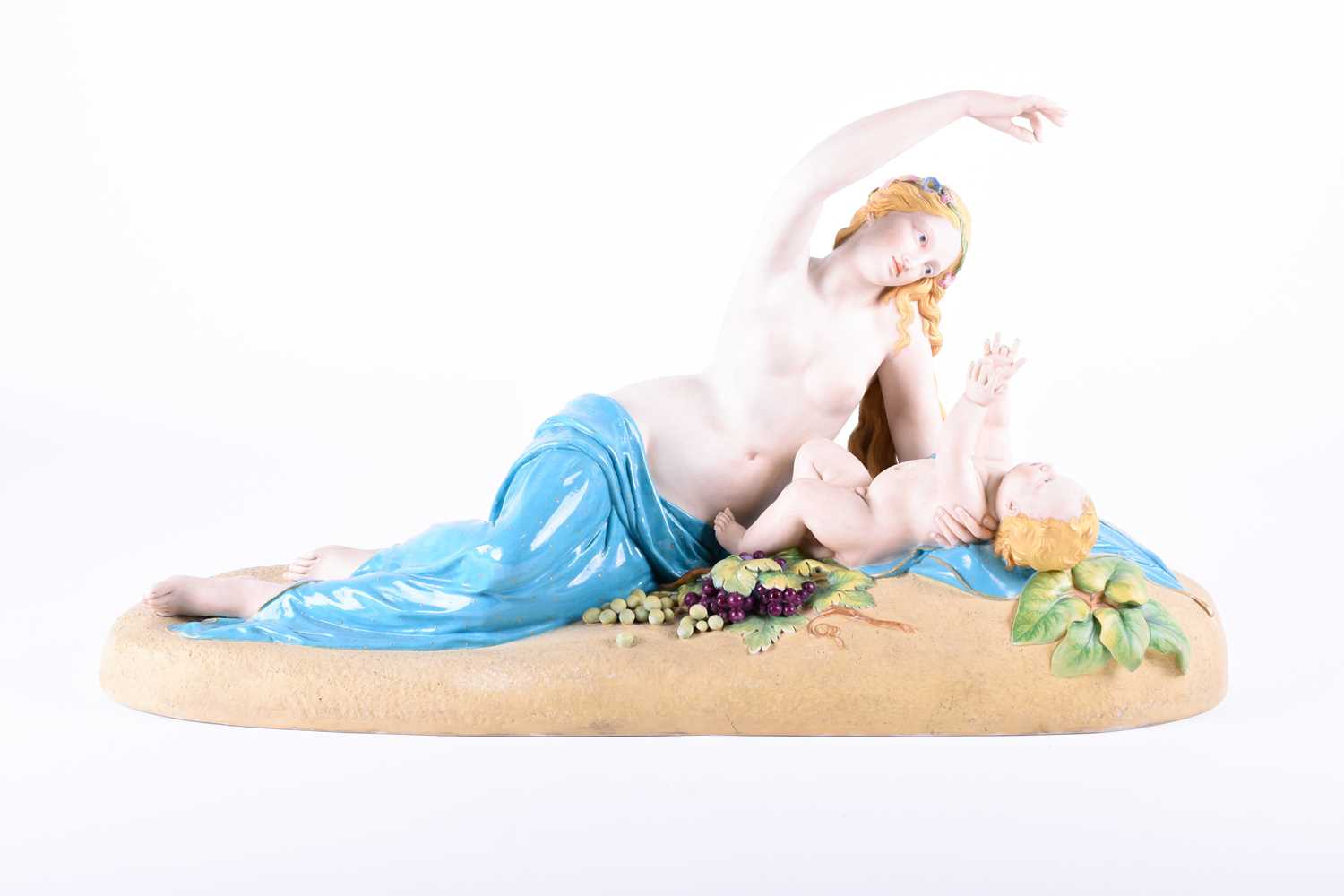
Try LotSearch and its premium features for 7 days - without any costs!
Be notified automatically about new items in upcoming auctions.
Create an alert